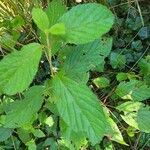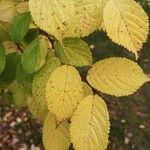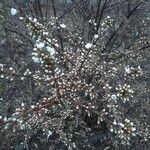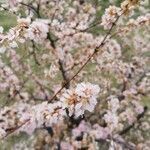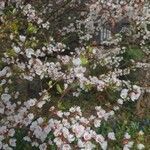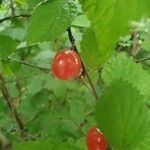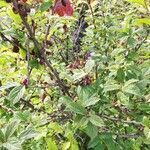Shrubs, not suckering, 10–20 dm, not thorny. Twigs with terminal end buds, densely hairy. Leaves deciduous; petiole 2–7 mm, hairy, eglandular; blade obovate to oblong-elliptic, 3–6(–7.5) × 1.7–3.5(–4.7) cm, base obtuse to rounded, margins coarsely, singly to doubly serrate, teeth sharp, usually eglandular, sometimes glandular, ?glands dark, spheric?, apex abruptly short-acuminate to acute, abaxial surface tomentose, adaxial ?rugose?, hairy, sometimes sparsely so. Inflorescences usually solitary flowers, sometimes 2-flowered fascicles. Pedicels 0–5 mm, hairy. Flowers blooming before or at leaf emergence; hypanthium tubular, 3.5–6 mm, glabrous or sparsely hairy (especially at bases) externally; sepals spreading, ovate, 2.5–3.5 mm, margins serrate, sometimes glandular, abaxial surface hairy, adaxial glabrous; petals white to pale pink (pink in bud), obovate or elliptic to suborbiculate, 9–13 mm; ovaries glabrous proximally, villous distally. Drupes red, globose, 8–15 mm, sparsely hairy; mesocarps fleshy; stones ellipsoid, not flattened. 2n = 16.
More
A small deciduous shrub. It has many branches. It grows 2 m high and spreads 2.4 m wide. The young stems are downy. The leaves are deep green and are puckered. They are 5 cm long and are fluffy underneath. The flowers are white to pale pink. They are 25 mm across and are single or in pairs. The fruit are small, round and red. They are about 1.25 cm across. There are some named cultivated varieties.
Slopes and in ravines, at elevations from 1,700-2,400 metres in the Himalayas. Forest on mountain slopes, forest margins, thickets and meadows; at elevations from 100-3,700 metres.
More
It is a cool temperate plant. It grows in northern China. It suits hardiness zones 2-8. In Sichuan and Yunnan.

